
Leh is a city in Indian-administered Ladakh in the disputed Kashmir region. It is the largest city and the joint capital of Ladakh. Leh, located in the Leh district, was also the historical capital of the Kingdom of Ladakh. The seat of the kingdom, Leh Palace, the former residence of the royal family of Ladakh, was built in the same style and about the same time as the Potala Palace in Tibet. Since they were both constructed in a similar style and at roughly the same time, the Potala Palace in Tibet and Leh Palace, the royal residence, are frequently contrasted. Leh is at an altitude of 3,524 m (11,562 ft), and is connected via National Highway 1 to Srinagar in the southwest and to Manali in the south via the Leh-Manali Highway.
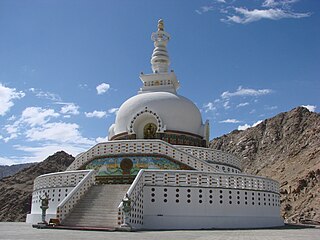
A Peace Pagoda is a Buddhist stupa: a monument to inspire peace, designed to provide a focus for people of all races and creeds, and to help unite them in their search for world peace. Most, though not all, peace pagodas built since World War II have been built under the guidance of Nichidatsu Fujii (1885–1985), a Buddhist monk from Japan and founder of the Nipponzan-Myōhōji Buddhist Order. Fujii was greatly inspired by his meeting with Mahatma Gandhi in 1931 and decided to devote his life to promoting non-violence. In 1947, he began constructing Peace Pagodas as shrines to world peace. The first was inaugurated at Kumamoto in 1954.
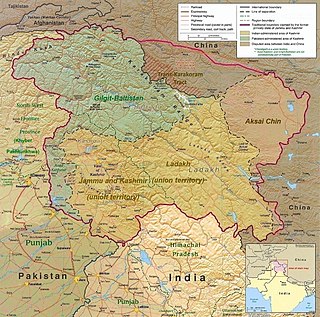
Ladakh has a long history with evidence of human settlement from as back as 9000 b.c. It has been a crossroad of high Asia for thousands of years and has seen many cultures, empires and technologies born in its neighbours. As a result of these developments Ladakh has imported many traditions and culture from its neighbours and combining them all gave rise to a unique tradition and culture of its own.
The Students' Educational and Cultural Movement of Ladakh is an Indian non-governmental organisation based in Leh, Ladakh, India.

Rizong gompa, Gelugpa or Yellow Hat Buddhist monastery is also called the Yuma Changchubling in Ladakh, India. It is situated at the top of a rocky side valley on the north side of the Indus, to the west of Alchi on the way to Lamayuru. It was established in 1831 by Lama Tsultim Nima under the Gelukpa order, at Ri-rdzong. There are 40 monks in the monastery. The monastery is also called "the paradise for meditation" and is noted for its extremely strict rules and standards. The nunnery, located about 2 km from the monastery, is called the "Jelichun Nunnery" or Chulichan (Chomoling), where, at present, 20 nuns reside. It is north of Srinagar-Leh highway & north of Mangyu temple complex.
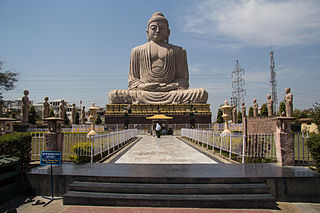
In religion and spirituality, a pilgrimage is a long journey or search of great moral significance. Sometimes, it is a journey to a sacred place or to a shrine of importance to a person's beliefs and faith. Members of every major religion participate in pilgrimages. A person who makes such a journey is called a pilgrim.

Thiksey Monastery or Thiksey Gompa is a Buddhist monastery affiliated with the Gelug school of Tibetan Buddhism. It is located on top of a hill in Thiksey approximately 19 kilometres (12 mi) east of Leh, in the Ladakh region of northern India. It is noted for its resemblance to the Potala Palace in Lhasa, Tibet, and is the largest monastery in central Ladakh, notably containing a separate set of buildings for female renunciates that has been the source of significant recent building and reorganization.

Korzok, དཀོར་མཛོད་ is a Tibetan Buddhist monastery belonging to the Drukpa Lineage. It is located in the Korzok village, on the northwestern bank of Tso Moriri, a lake in Leh District of Ladakh, a union territory of India. The gompa (monastery), at 4,560 metres (14,960 ft), houses a Shakyamuni Buddha and other statues. It is home to about seventy monks.
In Buddhism, a Kalachakra stupa is a stupa whose symbolism is not connected to events in the Buddha's life, but instead to the symbolism of the Kalachakra Tantra, created to protect against negative energies. It is the rarest kind of stupa.

Likir Monastery or Likir Gompa (Klud-kyil) is a Buddhist monastery in Ladakh, Northern India. It is located at 3700m elevation, approximately 52 kilometres (32 mi) west of Leh. It is picturesquely situated on a little hill in the valley, in Likir village near the Indus River about 9.5 kilometres (5.9 mi) north of the Srinigar to Leh highway. It belongs to the Gelugpa sect of Tibetan Buddhism and was established in 1065 by Lama Duwang Chosje, at the command of the fifth king of Ladakh, Lhachen Gyalpo (Lha-chen-rgyal-po). It is off the Leh-Kargil Highway, 50 km west of Leh between Alchi & Basgo, 17 km west of Basgo Monastery & 21 km northeast of Alchi Monastery.

Takthok Monastery is a Buddhist monastery in Sakti village in Ladakh, northern India, located approximately 46 kilometres east of Leh. It is the only monastery in Ladakh belonging to the Nying-ma-pa or Red Hat sect. The name is Takthok, literally meaning 'rock-roof' was named because both its roof and walls are made of rock. It belongs to the Nyingma tradition of Tibetan Buddhism and approximately 55 lamas reside there. It is the only Nyingma monastery in Ladakh.

Diskit Monastery also known as Deskit Gompa or Diskit Gompa is the oldest and largest Buddhist monastery (gompa) in Diskit, Nubra Valley of the Leh district of Ladakh. It is 115 km north of Leh.
Dzongkhul Monastery or Zongkhul Gompa is located 30 km northwest of Padum in the Stod Valley of Zanskar in Ladakh, northern India. Like the Sani Monastery, it belongs to the Drukpa school of Tibetan Buddhism

Stok Monastery or Stok Gompa is a Buddhist monastery in Stok, Leh district, Ladakh, northern India, 15 kilometres south of Leh. It was founded by Lama Lhawang Lotus in the 14th Century and has a notable library including all 108 volumes of the Kangyur. A ritual dance-mask festival is held annually.

Pokhara Shanti Stupa is a Buddhist monument on Anadu Hill of the former Pumdi Bhumdi Village Development Committee, in the district of Kaski, Nepal.
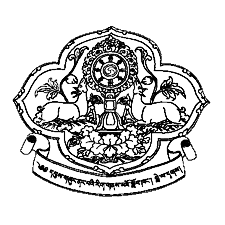
The Central Institute of Buddhist Studies, formerly known as the School of Buddhist Philosophy, located in Leh town of Ladakh is a deemed university under Ministry of Culture. It was founded in 1959 and formerly affiliated to the Sampurnanand Sanskrit University in Varanasi.
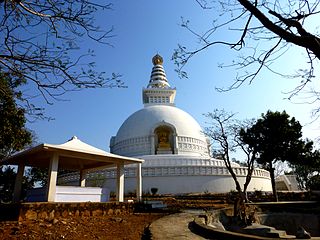
Vishwa Shanti Stupa is a large white Peace Pagoda in Rajgir, Nalanda District, Bihar, near Gitai Mandir. Statues of the Buddha are mounted on the stupa in four directions. It also has a small Japanese Buddhist temple with a large park. There is a temple near the stupa where prayers are conducted for universal peace. The initial pagoda was completed in 1969. New initiatives in 1993 resulted in the present form. It is one of around 80 Peace Pagodas which have been built around the world by the neo-Buddhist organisation Nipponzan Myohoji. These were a dream of Nichidatsu Fujii, inspired by Mohandas K. Gandhi, as a reaction to the atomic bombing of Japan, the first, and more well known Vishwa Shanti stupa, being built on Ratnagiri Hill in Rajgir.

Bhikshu Gyomyo Nakamura is a Japanese Buddhist monk, fairytale writer and musician.

Shanti Stupa is a Buddhist monument in Delhi, India, intended as "a symbol of universal brotherhood and peace." It is one of several Peace Pagodas in the world. Started by the Nipponzan-Myōhōji-Daisanga religious order of Buddhism, it was inaugurated by the Dalai Lama on 4 November 2007.

The Buddha Preaching his First Sermon is a stone sculpture of the 5th-century CE showing Gautama Buddha in the "teaching posture" or dharmachakra pravartana mudrā. The relief is 5' 3" tall, and was excavated at Sarnath, India by F. O. Oertel during the 1904–1905 excavation season of the Archaeological Survey of India (ASI); it was found in an area to the south of the Dhamek Stupa.





















